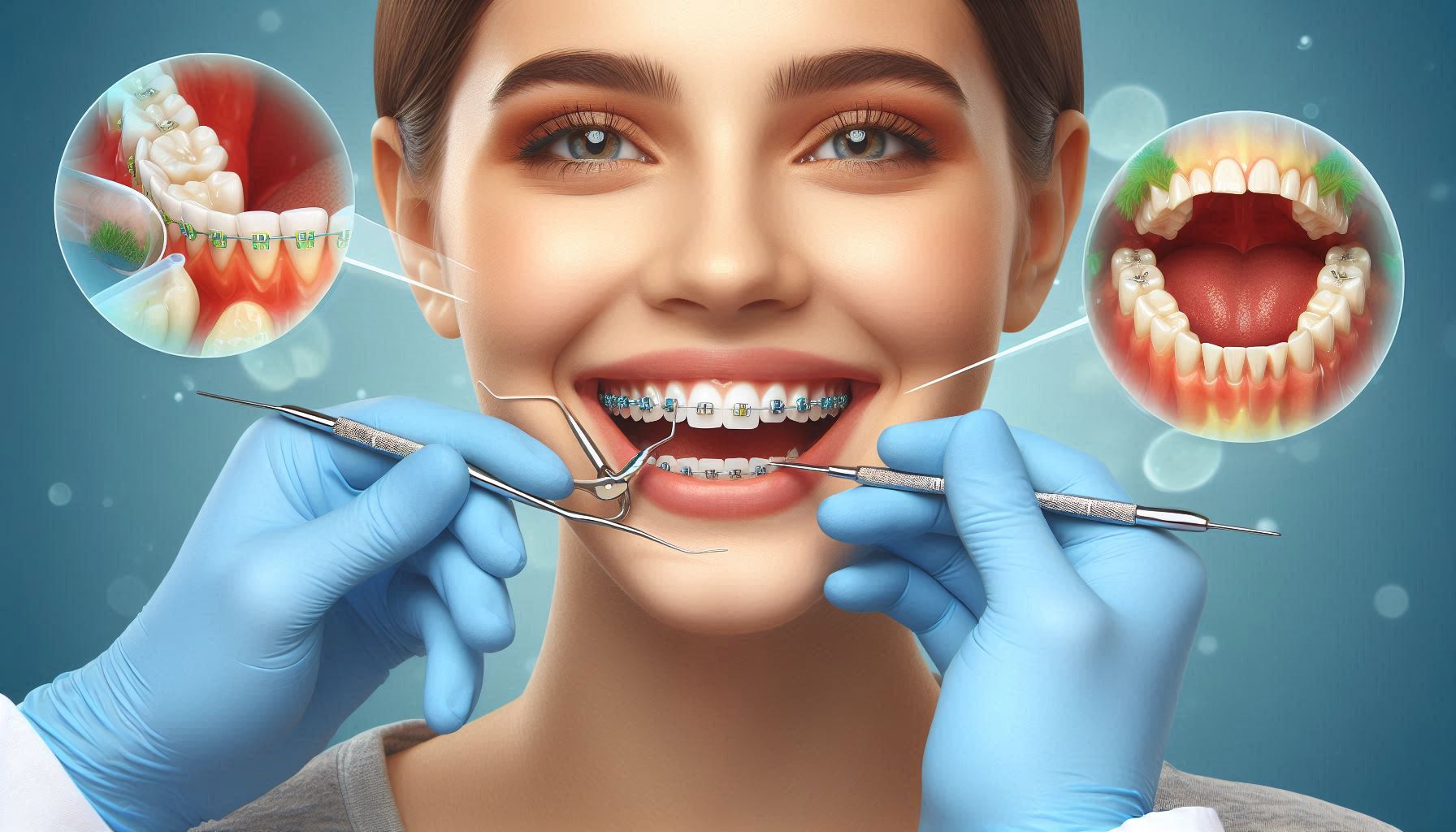Introduction
Orthodontics is a specialized field of dentistry dedicated to diagnosing, preventing, and correcting misaligned teeth and jaws. While orthodontics is often associated with improving the aesthetics of a smile, its role in promoting better oral health is equally important. A well-aligned bite, where the teeth and jaws function in harmony, can lead to a lifetime of better oral health, comfort, and confidence. Misaligned teeth or malocclusions (incorrect bites) can affect not just the appearance of your smile, but also your ability to chew, speak, and maintain proper oral hygiene. These issues can increase the risk of tooth decay, gum disease, and other dental problems.
This guide takes an in-depth look at how orthodontics works, its significance in improving oral health, and the wide-ranging benefits that go beyond the cosmetic. By understanding how orthodontic treatment can improve your bite and overall oral health, you will gain insight into why orthodontic care is crucial for both children and adults alike.
The Core Principles of Orthodontics
Orthodontics encompasses more than just aligning teeth for a better appearance. The main focus is to correct malocclusions and ensure that your teeth and jaws align correctly. To understand this, it is essential to grasp some basic orthodontic principles:
- Occlusion: This refers to the way your teeth come together when you bite. Proper occlusion ensures that the upper and lower teeth meet in a balanced, functional, and comfortable manner. Malocclusion (an improper bite) can occur when teeth are crooked, misaligned, or positioned incorrectly.
- Alignment: This is about the positioning of individual teeth within the mouth. Teeth that are misaligned may be crooked, tilted, or spaced unevenly. Correcting these issues improves both the function and aesthetics of the teeth.
- Jaw Position: Misalignment of the jaws (upper and lower) can also create bite issues. For example, an overbite occurs when the upper jaw protrudes excessively over the lower jaw, and an underbite occurs when the lower jaw extends beyond the upper jaw. This misalignment may lead to problems with chewing, speaking, and jaw discomfort.
The Link Between Bite and Oral Health
While the aesthetic benefits of a straight smile are widely appreciated, the way your teeth and jaws function is paramount for long-term oral health. Misaligned teeth or jaw issues can lead to a host of oral health problems, some of which can be severe and progressive. Let’s take a deeper dive into how bite misalignment can affect your oral health.
- Jaw Pain and TMJ Disorders: When teeth do not fit together properly, the muscles in the jaw work harder to compensate for the misalignment. Over time, this added strain can lead to pain and dysfunction in the temporomandibular joint (TMJ), which connects the jaw to the skull. TMJ disorders are often accompanied by headaches, jaw clicking, earaches, and difficulty in opening or closing the mouth.
- Tooth Wear and Damage: An improper bite can cause teeth to come into contact in unnatural ways, leading to uneven wear on the enamel. This can cause tooth fractures, cracks, or premature erosion, making the teeth more susceptible to cavities and decay.
- Speech and Chewing Problems: Malocclusions can affect the way you speak and chew. For instance, an open bite or crossbite may interfere with certain speech sounds, making pronunciation difficult. Similarly, improper bite alignment can hinder efficient chewing, causing digestive problems as food is not broken down properly.
- Increased Risk of Tooth Decay and Gum Disease: Misaligned teeth are harder to clean, leading to plaque buildup, which increases the risk of tooth decay and gum disease. When teeth overlap or are too close together, it becomes difficult to reach areas between the teeth with a toothbrush or floss. The result is a higher likelihood of cavities, gingivitis, and periodontal disease.
- Breathing Problems: Malocclusions, especially severe cases like underbites or overbites, can contribute to obstructed airways, leading to issues such as snoring or sleep apnea. These breathing disturbances not only affect sleep quality but can also contribute to other systemic health issues, including cardiovascular problems and reduced oxygen levels.
By undergoing orthodontic treatment, these bite-related issues can be corrected, improving both the functionality and health of your teeth and jaw.
Types of Malocclusions and How Orthodontics Can Correct Them
Orthodontic treatment is designed to address a variety of bite problems, or malocclusions. Below, we explore the most common types of malocclusions that orthodontics can correct, and how treatment works to resolve them.
Overbite (Deep Bite)
An overbite occurs when the upper teeth significantly overlap the lower teeth. It can result in uneven wear, tooth sensitivity, and strain on the jaw joint. Severe cases of overbite can also cause damage to the lower teeth. Braces or clear aligners can gradually move the teeth into a more aligned position, reducing the overbite and balancing the bite.
Underbite
An underbite happens when the lower jaw is positioned forward relative to the upper jaw, causing the lower teeth to protrude past the upper teeth. This misalignment can make it difficult to chew and speak properly and can lead to tooth wear, gum problems, and jaw pain. Orthodontic treatment for underbites may involve the use of braces, aligners, or, in some cases, surgical intervention to reposition the jaw.
Crossbite
A crossbite occurs when one or more of the upper teeth bite on the inside of the lower teeth. This can happen at the front or back of the mouth and can lead to uneven tooth wear, gum disease, and bone loss over time. Crossbite correction typically involves expanding the upper jaw with an expander device or using braces or clear aligners to shift the teeth into a more proper alignment.
Open Bite
An open bite occurs when there is a gap between the upper and lower teeth when the mouth is closed, preventing the teeth from meeting properly. It can make chewing difficult and may also affect speech. Orthodontic treatment for an open bite may involve the use of braces, retainers, or, in severe cases, surgical correction to reposition the jaw.
Crowded Teeth
Crowded teeth occur when there is not enough space in the mouth for all the teeth to align properly. Teeth may overlap, twist, or become impacted. Crowded teeth are harder to clean, increasing the risk of cavities and gum disease. Braces or clear aligners are typically used to move the teeth into their proper positions, creating more space for better alignment and improved oral hygiene.
Spacing (Diastema)
Spacing, or gaps between teeth, can also be problematic, particularly in the front teeth. While some gaps are purely cosmetic, larger spaces can contribute to food getting trapped between teeth, leading to a higher risk of cavities and gum disease. Orthodontic treatment can help close these gaps by moving the teeth into more optimal positions.
The Orthodontic Treatment Process: Step-by-Step
Orthodontic treatment is a gradual process that involves careful planning and monitoring. Here’s a step-by-step guide to what you can expect during your orthodontic journey.
Initial Consultation and Examination
The journey toward orthodontic treatment begins with an in-depth consultation with a qualified orthodontist. During this initial visit, the orthodontist will conduct a comprehensive examination of your oral health. This will likely include taking X-rays to assess the position of your teeth and jawbones, as well as capturing photographs to document your current dental condition. Additionally, the orthodontist may take impressions or digital scans of your teeth to create accurate models that help in planning the most effective treatment. This thorough examination allows the orthodontist to diagnose the specific type of malocclusion (misalignment) you have and determine the best course of action for your treatment. Whether you need braces, clear aligners, or other orthodontic appliances, this step is crucial for creating a personalized treatment plan tailored to your unique needs.
Developing a Treatment Plan
After completing the examination, the orthodontist will develop a customized treatment plan to address your specific dental issues. This plan will consider factors such as the severity of the malocclusion, your age, lifestyle, and any other relevant oral health conditions. The treatment plan will detail the type of orthodontic appliances needed—whether traditional metal braces, ceramic braces, or clear aligners. The orthodontist will also provide an estimate of the treatment duration, which typically ranges from several months to a few years, depending on the complexity of the case. Additionally, the plan will outline the frequency of follow-up appointments, which are necessary to track your progress and make any adjustments along the way. Clear communication about the treatment plan is essential, ensuring you understand the steps involved and what to expect during the course of your orthodontic care.
Placement of Braces or Clear Aligners
Based on the treatment plan, the orthodontist will proceed with placing the appropriate appliances to begin realigning your teeth. For those receiving traditional braces, this involves bonding small metal brackets to the surface of your teeth. These brackets are connected by a wire, which will be tightened periodically to apply controlled pressure to your teeth, gradually shifting them into alignment. For patients opting for clear aligners, the process involves creating a series of custom-made, transparent trays that are designed to fit snugly over your teeth. These trays will be worn for a set period and replaced with new ones at regular intervals to continue shifting your teeth in the desired direction. Whether you choose braces or clear aligners, the goal is to move your teeth into proper alignment step by step.
Adjustments and Monitoring
Throughout the course of your treatment, regular appointments will be scheduled to monitor your progress and make necessary adjustments. For patients with traditional braces, this typically involves periodic visits to tighten the wires, ensuring that continuous pressure is applied to shift the teeth gradually. For those using clear aligners, the trays will be swapped out every few weeks for a new set that moves your teeth closer to their final position. These check-ups are essential to ensure the treatment is proceeding as planned and that the desired changes are taking place. In some cases, the orthodontist may make adjustments to your appliances to address specific issues or ensure the most effective treatment.
Retention Phase
Once the active phase of treatment is complete, and your teeth have reached their correct alignment, the retention phase begins. Retainers are used to help maintain the new position of your teeth and prevent them from shifting back to their original alignment. Depending on your case, the orthodontist may recommend wearing your retainers full-time initially, gradually reducing the wear time as your teeth stabilize in their new positions. Retainers may be either removable or fixed, depending on the needs of your specific case. It is crucial to follow the orthodontist’s instructions for retainer wear to ensure long-lasting results and maintain the beautiful smile you’ve worked so hard to achieve.
The Benefits of Orthodontic Treatment
Orthodontic treatment offers far-reaching benefits that extend beyond cosmetic improvements. Here are some of the most significant advantages:
Improved Oral Health
One of the most significant benefits of orthodontic treatment is the improvement in overall oral health. Misaligned teeth can create challenges when it comes to maintaining proper oral hygiene. Crooked teeth, crowded teeth, or gaps between them can make it difficult to thoroughly clean the surfaces of your teeth. As a result, plaque and food particles may remain trapped, increasing the risk of developing cavities and gum disease. Orthodontic treatment realigns the teeth, making it easier to brush and floss effectively. When teeth are aligned properly, it’s much simpler to clean each surface, preventing the buildup of harmful bacteria and plaque. With consistent brushing and flossing, the likelihood of tooth decay, gum disease, and other oral health issues decreases significantly. By improving the ease of daily oral hygiene, orthodontics plays a vital role in promoting long-term oral health and preventing complex dental problems in the future.
Enhanced Functionality
Another key advantage of orthodontic treatment is the improvement in the functionality of your mouth. When your bite is misaligned, the teeth may not come together properly, which can lead to problems when chewing, speaking, or even breathing. For example, overbites, underbites, and crossbites can make it difficult to chew food efficiently, potentially leading to digestive issues. Misalignment can also place excessive strain on the jaw muscles, resulting in discomfort, pain, and even headaches. Over time, this can cause more serious conditions, such as temporomandibular joint (TMJ) disorders. Orthodontic treatment helps align the teeth and jaws, ensuring they work together efficiently during chewing and speaking. By correcting these issues, you alleviate pain and discomfort while improving overall functionality. A properly aligned bite makes everyday tasks like eating, speaking, and breathing more comfortable and efficient.
Reduced Risk of Tooth Wear
Misaligned teeth can lead to uneven wear on the surfaces of your teeth, which can result in cracks, fractures, or enamel erosion over time. When teeth don’t meet properly, they may rub against each other in ways that cause unnecessary wear. This excessive wear can make teeth more susceptible to cavities, sensitivity, and even tooth loss. By realigning the teeth with orthodontic treatment, this issue is significantly reduced. Properly aligned teeth distribute biting forces more evenly, which helps prevent excessive wear and tear. As a result, your teeth are better protected against damage and can maintain their strength and functionality over time, reducing the risk of requiring extensive dental work or restorations in the future.
Improved Aesthetics and Confidence
A beautifully aligned smile can have a profound effect on an individual’s confidence and self-esteem. Many people who struggle with crooked, misaligned, or gapped teeth often feel self-conscious about their appearance, especially when smiling or speaking. This can lead to social anxiety or reduced confidence in personal or professional situations. Orthodontic treatment, which works to correct alignment issues, can significantly improve the aesthetics of your smile. With a more attractive, symmetrical smile, you may feel more confident in social settings, enjoy more positive interactions, and even experience a boost in self-esteem. Beyond just appearance, a well-aligned smile reflects the effort put into personal care, which can make you feel more confident about your overall health and well-being.
Preventing Future Dental Issues
One of the most important benefits of orthodontic treatment is the prevention of future dental problems. Addressing bite issues early on reduces the likelihood of more complex and costly dental treatments in the future. Malocclusions that are left untreated may lead to long-term complications such as tooth decay, gum disease, jaw pain, and even tooth loss. Misalignments can also cause excessive wear and strain on certain teeth, leading to damage or the need for restorative procedures such as crowns or fillings. By correcting these issues early, orthodontics helps minimize the risk of more serious conditions that could require extensive treatment. Moreover, early intervention in children can help guide proper jaw development, preventing the need for more invasive procedures later in life. Preventing these issues saves both time and money while promoting a lifetime of healthy teeth and gums.
Conclusion
Orthodontics is an essential branch of dentistry that offers far more than just cosmetic improvements. Through orthodontic treatment, individuals can achieve a well-aligned bite that improves both the functionality and health of their teeth and jaws. The benefits extend beyond aesthetics, addressing functional problems, preventing tooth wear, and ensuring better oral hygiene. Orthodontics provides patients with the opportunity to enhance their smiles and improve their overall quality of life, making it an investment in both health and confidence. Whether you’re a child, teenager, or adult, orthodontic care can help you achieve the smile you’ve always desired, with long-lasting health benefits to match.
SOURCES
Adams, S. (2019). Orthodontic treatment and its impact on overall oral health. Dental Health Press.
Barker, L. R., & Miller, T. P. (2021). The role of orthodontics in preventing gum disease: A comprehensive review. Journal of Orthodontics, 48(2), 134-142.
Chavez, R. D. (2020). Malocclusions and their relationship to temporomandibular joint disorders. American Journal of Orthodontics, 32(6), 456-463.
Dawson, R. S., & Freeman, J. M. (2018). Overbite correction: Methods and outcomes. International Journal of Dental Studies, 15(4), 111-117.
Evans, L. J. (2017). The effects of early orthodontic intervention on children’s bite. Clinical Pediatric Dentistry, 42(3), 89-95.
Fleming, C. M., & Johnston, K. H. (2019). Managing jaw misalignment: Treatment options in orthodontics. Journal of Clinical Dentistry, 21(5), 43-51.
Griffiths, P. B., & Thompson, K. J. (2022). The psychological benefits of orthodontic treatment. Dental Psychology Review, 7(1), 58-65.
Harrison, D. J. (2021). Braces versus aligners: A comparison of treatment effectiveness. Orthodontic Times, 35(4), 10-14.
Johnson, S. D., & Williams, A. B. (2020). Jaw surgery and orthodontics: How they work together for better outcomes. Dental Practice Today, 26(3), 221-228.
Klein, R. A., & Smith, B. F. (2018). Orthodontic treatments for adults: Addressing the rise in demand. Journal of Adult Orthodontics, 18(2), 87-93.
Morris, P. E. (2022). Managing crossbites in orthodontics: Techniques and best practices. Journal of Advanced Orthodontics, 13(6), 245-253.
Patel, D. H. (2021). The significance of proper bite alignment in preventing future dental issues. American Dental Journal, 49(7), 301-305.
Turner, J. C., & Hunt, C. E. (2020). The influence of orthodontic treatment on long-term oral health. Journal of Orthodontic Research, 12(3), 211-219.
Williams, E. R. (2019). Effectiveness of orthodontics in treating malocclusions. Journal of Modern Orthodontics, 6(4), 111-119.
Zimmer, H. P., & Jones, L. R. (2017). Preventing tooth decay with orthodontics. Dental Health Journal, 40(2), 67-74.
HISTORY
Current Version
February 11, 2025
Written By:
SUMMIYAH MAHMOOD




